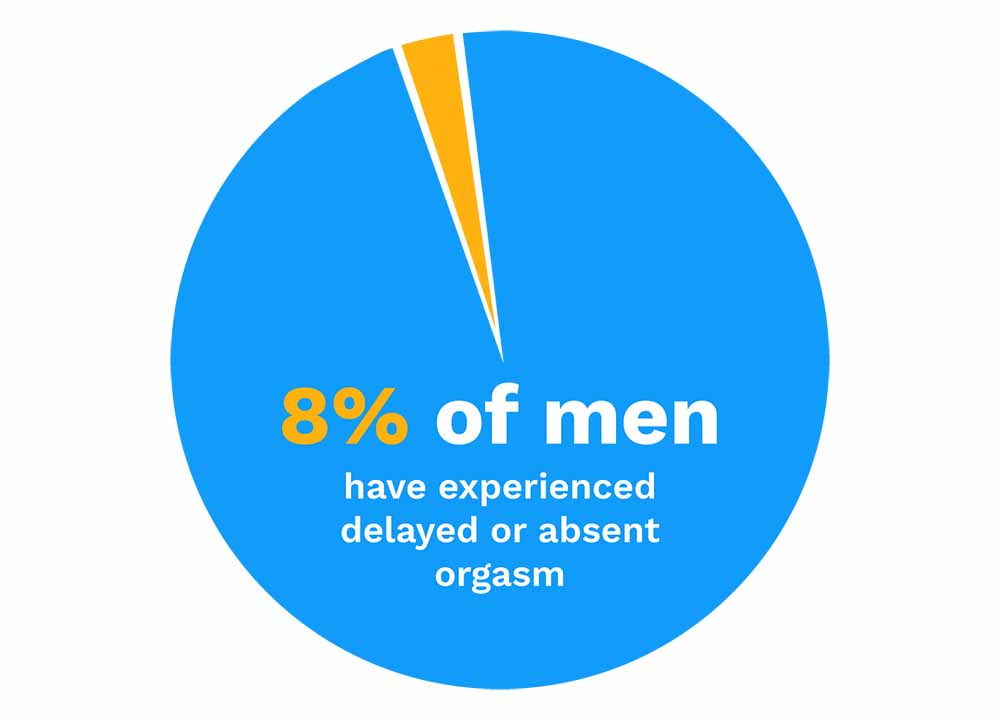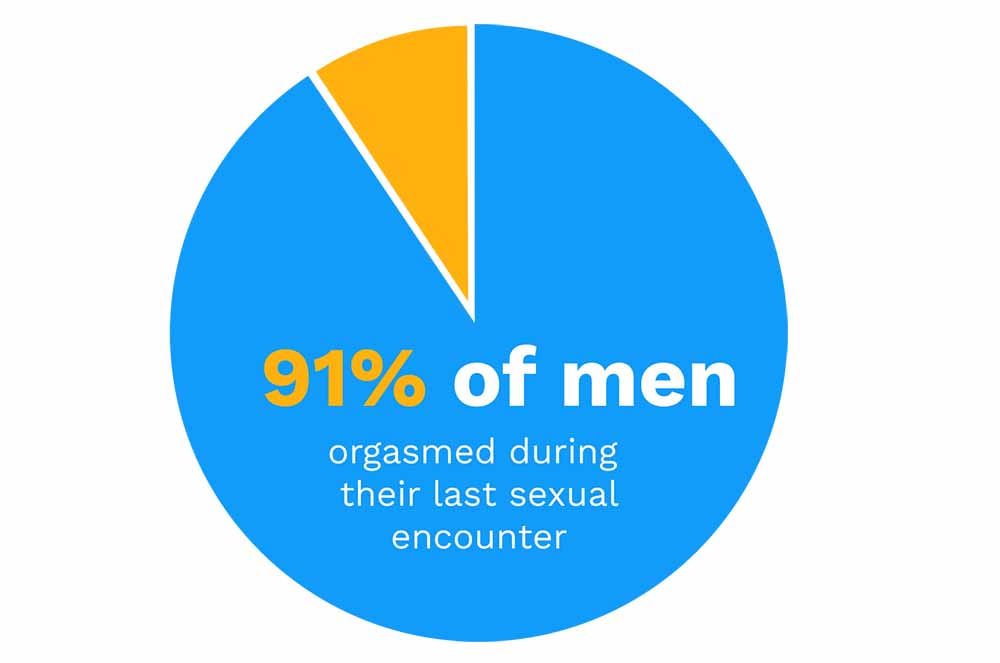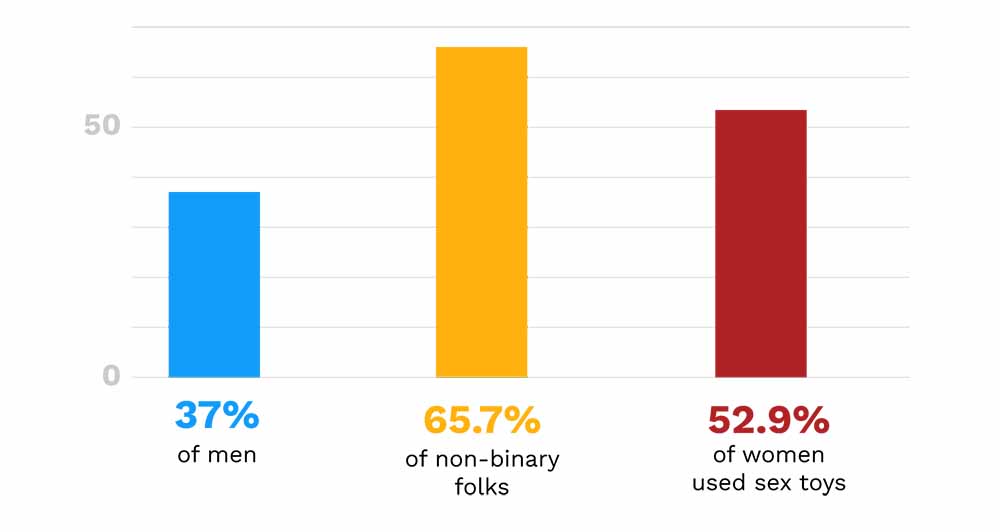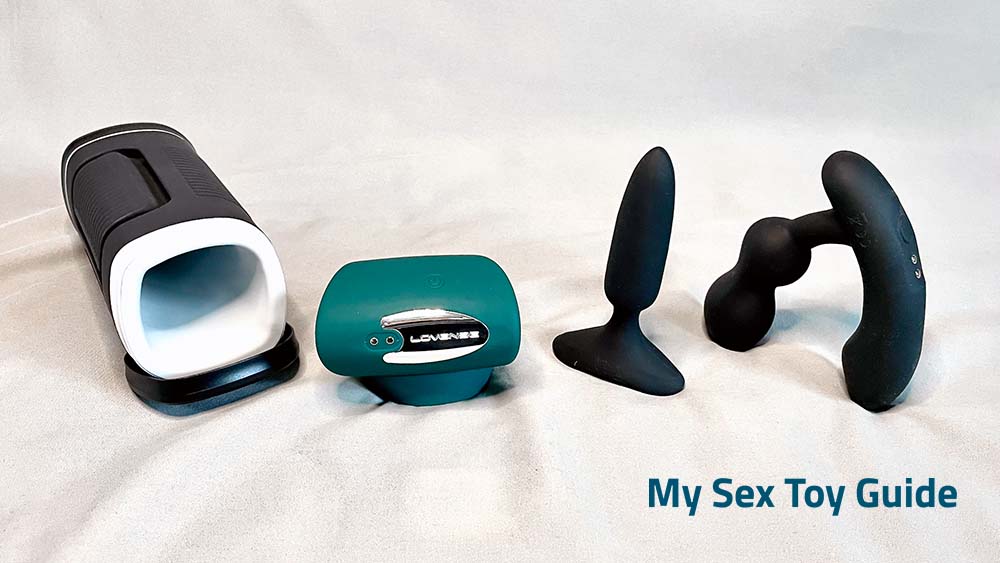Overall, men are doing pretty well in the pleasure and orgasm realm. That is, unless we measure their success by how often their partner orgasm! Although there have been great strides in recent years, we tend to live in a culture that prioritizes male pleasure over female pleasure. So let’s explore what we know about orgasm statistics for men, especially as new technology (VR pornography, smart sex toys, etc) has entered the market and how we look at sex and relationships have shifted.
- The median age of the first orgasm for men was 14 years old.
- Men take about 5.4 minutes to orgasm during penetration
- 91% of men orgasmed during their last sexual encounter.
- 8% of men have experienced delayed or absent orgasm.
- 55% of men said yes when I asked men if they had ever achieved an orgasm with a sex toy.
- 37% of men, 65.7% of non-binary folks, and 52.9% of women used sex toys.
- Only 5% of the respondents had orgasmed using VR porn.
- Only 5% shared that they orgasmed with a smart sex toy.
Table Of Contents
General Sex Differences
Before we dig into the stats, it’s important to point out that biological and cultural factors can impact the difference in orgasm frequency between men and women. Culturally, male pleasure is prioritized. Pornography is often made for men by men, so it is no surprise that it shows significantly more blow jobs than cunnilingus.
Similarly, research has shown that in many Hollywood movies, male characters are more likely to engage in sexual behavior and experience orgasm than their female counterparts (find my female orgasm statistics here). For some folks, being raised with these images will lead them to think that male pleasure is more important and to prioritize it in their sexual relationships.
There are also biological reasons men may have a higher orgasm frequency than women. Most men have a single external genital organ (the penis) which can be highly sensitive to sexual stimulation. In contrast, women have a more beautifully complex internal genital anatomy, including the clitoris, vagina, and G-spot, which can require more time and effort to stimulate to achieve orgasm. As a result, if male pleasure is prioritized, it logically follows that some women may not engage in the self-exploration necessary to figure out what feels good for them.
Finally, unlike women, most men can’t have multiple orgasms. In one study, they found that it was less than 10% for those in their 20s, and less than 7% after the age of 30. Also, another study found that 25% of men have faked an orgasm, higher than women at 59%.
Orgasms without a Partner
Research suggests differences in the timing of when men and women experience their first orgasm. Studies have found that, on average, boys tend to have their first orgasm at a younger age than girls. One study published in the Journal of Sex Research found that the median age of first orgasm for boys was 14 years old, while for girls, it was 18 years old. Perhaps this is because men report experiencing less shame than women related to masturbation and sexual fantasies than men. Also, women may be socialized to view their bodies and sexual desire as sources of shame or embarrassment, while men may be encouraged to pursue sexual experiences and prioritize their pleasure.
There are hundreds of articles exploring anorgasmia, or the inability to achieve women orgasm, and very few articles exploring this experience for men. However, one study found that about 8% of men have experienced delayed or absent orgasm, which is when despite experiencing sufficient stimulation, ejaculation does not happen. However, This condition is less common among younger men and tends to have a root in a health condition, not psychological issues.
Indeed, overall, the research suggests that the vast majority of men have had an orgasm before. For example, one study found that 100% of men had an orgasm in their last sexual encounter when anal sex was involved, so it follows that that was likely not their first orgasm and that they have also likely had orgasms without a partner.
Orgasms with a partner
There is a fair amount of research on orgasm frequency, with results showing that during partnered encounters men tend to be significantly more likely to orgasm than women – a phenomenon known as the orgasm gap.
One study found that 91% of men orgasmed during their last sexual encounter, whereas only 64% of women could say the same. Another study broke the results down by sexual orientation and found that heterosexual men were most likely to say they usually orgasm in their sex life (95%), followed by gay men (89%), bisexual men (88%), lesbian women (86%), bisexual women (66%), and heterosexual women (65%). Indeed, regardless of sexual orientation, men tend to orgasm more than women, with the largest difference found between heterosexual men and women. Also, Premature Ejaculation (PE) affects 20-30% of men in the sexually active age group (source here)
Perhaps, part of this has to do with the fact that men generally reach orgasm faster than women both during masturbation and in vaginal intercourse. Men take about 5.4 minutes to orgasm during penetration and their orgasms last from a few seconds to a few minutes. So if men’s pleasure is prioritized and they orgasm first, that may lead sexual encounters to end before the woman can get there. The gender difference in arousal and orgasm may also help explain why there isn’t as big an orgasm gap in queer relationships, as they are on a more similar timeline.
Men and Sex Toys
One area of sexual satisfaction that tends to prioritize the female orgasm is the sex toy realm. A wave of feminism and the pursuit of sexual liberation have led to increased acceptance of sex toys among women. Vibrators, dildos, clitoral stimulation toys, and other fun toys have become symbols of empowerment and unapologetic pleasure for women. Meanwhile, cultural taboos and traditional masculine ideals often discourage men from openly embracing toys in the same way.
I spoke to Dr. Nazanin Moali and she explained, “The enduring stereotype that men’s sexual function is uncomplicated and always ready at a moment’s notice has traditionally implied a lesser need for enhancements or aids, thus potentially linking the use of such products to perceived deficiencies. Men’s sexual health is deeply intertwined with their identity, and any implication that they may not be ‘adequate enough’ without the assistance of sex toys could contribute to the stigma.”
I wanted to understand how technology may be shifting men’s pleasure regimes, so I created a Poll of 20 people who follow my Sex Education Instagram. The results showed that when I asked people with penises if they had ever achieved an orgasm with a sex toy, 11 people (or 55%) said yes, and 9 people said no. This is a lower usage than when I surveyed people with vulvas on my socials and found that 93% of women had achieved orgasm with a toy.
When asked about their experience, one man who said they had never used a toy explained why saying “Ha no never. And yeah definitely feel like I’d never buy one simply because it “implies” I’m single and alone. ”One more open-minded person who used a toy before said, “I was amazingly surprised at how awesome (the sex toy) felt. I’ve even climaxed while my partner was using a vibrator. The vibes go right through them and into me. Glorious.”
When asked which sex toys they used, the responses ran the gamut from a prostate plug, inflatable sex dolls, “vibe on weiner”, blowjob simulator, Fleshlight, and Sleeve, to “do worn panties count?”
When looking at the gender differences in owning sex toys, a recent study of 1435 Canadian women found that 65% of women and nearly half of men own at least one sex toy. The results showed that of this group, during the period of the survey, 65.7% of non-binary folks, 52.9% of women, and 37% of men used sex toys. In conjunction with the research above, it appears that the stigma around men using toys is slowly decreasing, but overall women feel more comfortable owning and using toys.
VR Porn
As our technology continues to advance, so does our ability to use these advancements for sexual pleasure. Watching virtual reality porn involves putting on a VR headset or a smartphone fitted into headgear. VR porn can provide users with a more immersive and interactive experience compared to traditional forms of porn, as users can engage with and explore virtual adult content in a more lifelike and interactive manner. Indeed, research shows that when watching VR porn, users of all genders felt more desired, flirted with, and connected to porn stars than when watching regular porn.
In my social media survey, I also asked the fellas about their experience with having an orgasm using VR technology. Only 1 of the respondents (5%) had orgasmed using VR porn, but a few men followed up, saying that they are going to invest in a headset soon and are excited to experience it.
I spoke with Dr Moali about her predictions of the future of VR porn and she shared, “Due to the cost of getting the right equipment and also fewer options in terms of available performances, the majority of the porn users haven’t incorporated them in their daily lives.” However, she hypothesizes that as it becomes more affordable this will likely change.
Some larger studies suggest that men may have a slightly higher usage rate of VR porn compared to women. This could be influenced by factors such as men being more visually aroused than women, and a greater marketing emphasis on male-targeted VR porn content.
Smart Sex Toys
Smart sex toys are adult pleasure devices that incorporate technology, typically Bluetooth or Wi-Fi technology to enable various interactive features and remote control capabilities.
Just like with VR porn, in my social media survey Smart sex Toy usage was quite low – with only one man (5%) sharing that they orgasmed with a smart sex toy. When asked why they haven’t explored them, one of my users shared that they did not trust smart sex toys saying that “it would spy on them.”
The user that tried a smart toy shared that they used products from Lovense, and their partner controlled it while they were at dinner with hubby and it was a sexy good time.
Although smart sex toys are used by people of all genders, there is evidence to suggest that women more commonly use them. This may be because the market has more sex toys that cater to women’s pleasure and desires.
However, Dr. Nazanin Predicts, “In my professional view, the evolution of smart sex toys is reshaping traditional notions of gendered pleasure. What we’re seeing in the market is a move away from gender-focused design and a new emphasis on inclusivity and versatility.
Many of today’s offerings are designed with a universal appeal in mind, capable of providing pleasure to all genders or being utilized in couples’ play.” Indeed, it seems that we are slowly decreasing the stigma around sex toys and moving towards seeing pleasure as less gendered and more universal.
Conclusions
Overall the research still suggests that there are still rather large gender differences in orgasm frequency. Both men and women are affected by this disparity, whether it stems from societal perceptions of pleasure or the fact that individuals with vulvas often require more time and stimulation to reach climax. This situation must change, as sex is so much better for everyone, including heterosexual men when both partners’ pleasure is prioritized.
One effective way to bridge the orgasm gap is by drawing inspiration from the queer community, which has long emphasized open communication about desires and preferences. Additionally, exploring the vast range of sexual technologies and embracing sex toys can add a new dimension of pleasure, both when used solo and with partners.
By exploring these sexual practices, we can work towards closing the orgasm gap and creating more pleasurable and orgasmic sexual experiences for everyone involved. Happy exploring 🙂
Thanks for reading my male orgasm statistics!
Niki
Do you have any sex statistics questions? Ask us on Twitter.
- What Is A Hand Fetish? How to Safely Explore Quirofilia! - April 30, 2024
- An Exploration Of Panty Fetish And The Community - April 18, 2024
- An Exploration Of Armpit Fetish And The Community - April 16, 2024




